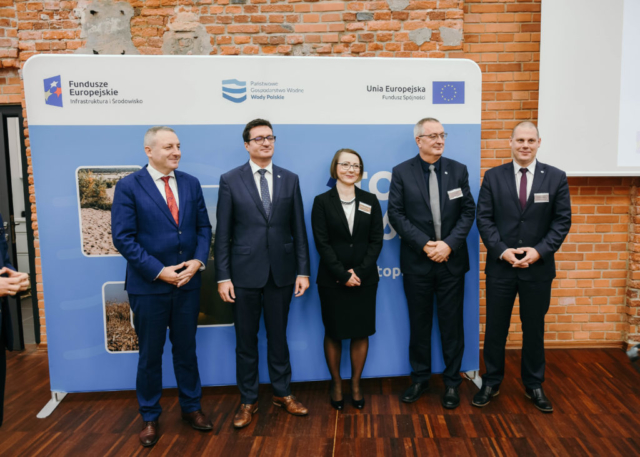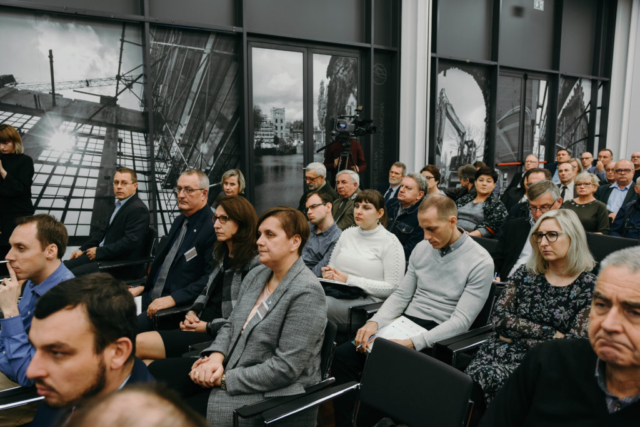As much as 59% of the Łódzkie Voivodeship is at a high or even extreme risk of agricultural drought. Due to the climatic and environmental conditions in central Poland, droughts there can be very intense during long periods without rainfall – a problem further exacerbated by the low availability of surface water resources. On 13 November, a discussion on how to resolve these issues was held in Łódź. This was the last such public consultation meeting of the year on drafting the Drought Effects Counteracting Plan (DECP).
A total of 7 out of the 25 activities in the most important part of the DECP project discussed in Łódź, i.e. the activity catalogue, were related to counteracting the effects of agricultural drought. They were aimed at increasing the amount of water retained in the soil, constructing and improving drainage systems, as well as developing and promoting good practices that mitigate the impact of drought. Increasing water retention in agricultural, forestry and urban areas in the Łódź region to further counteract the effects of drought is vital as well. Both natural and artificial retention solutions are planned to be used as part of this project. “We have already started work in the Łódzkie Voivodeship and plan to implement investment projects aimed at improving the water profiles of the Pilica River and the Sulejów Reservoir, as well as other activities. Another important task is the renovation of the weir at the Jeziorsko Reservoir and riverbed engineering works. From the point of view of counteracting drought, engineering the riverbed of the Moszczenica River, including reducing its gradient and the water flow speed, is a much-needed step as well”, said Przemysław Daca, President of the Polish Waters.
The Łódzkie Voivodeship is a rather unique area when it comes to hydrology. It is divided into two nearly equal parts by the watershed separating the Vistula and Odra river basins. Even with these, as much as a third of the whole voivodeship struggles with low availability of surface water resources. As a result, the use of groundwater resources in this area exceeds the national average by nearly 30%. “Our analysis shows that the strong pressure on using water resources during drought is a huge problem in this part of Poland. Since the conditions in this Voivodeship greatly contribute to this threat, as of now, 18% of its area is threatened by hydrological drought and 44% by hydrogeological drought (to a moderate extent)”, Daca added. Central Poland had already experienced drought several times in recent years. The droughts in 2015, 2018 and 2019 caused immensely high losses in agriculture. As a result, the Agency for Restructuring and Modernisation of Agriculture had to pay out more than PLN 2 billion in compensation in 2018 alone. The effects of this year’s hydrological and hydrogeological drought had a negative impact on the citizens of the Łódź region as well, especially in regard to drinking water supplies.
The provisions of the Water Law Act state that SWH Polish Waters as well as central and local government administration units must work to counteract the effects of drought. The catalogue of activities to be conducted as part of this process includes developing mechanisms to finance the works scheduled for 2021–2027. Entrepreneurs and even individual water users also have a role to play here, as they too will be obliged to implement some aspects of the DECP.
The consultation meetings on the DECP project began on 15 August 2019 and will continue until February 2020, when the last meeting will be held in Warsaw. By then, such meetings will have been held in 15 different cities across Poland (visit www.stopsuszy.pl to learn more).
The DECP is the first such comprehensive project on counteracting the effects of drought in Poland. Information about the DECP project is available at www.stopsuszy.pl and www.konsultacjesusza.pl. They also allow you to submit applications and comments to the DECP programme through a special form.
The DECP document, which will be the most important product of the Stop Drought! project, as well as the water and flood risk management plans, will greatly contribute to improving the water management processes in Poland. Following the public consultations, the DECP project will undergo a strategic environmental impact assessment. Following this, in 2020, the final step will be to formally adopt the project via a regulation prepared by the minister responsible for water management. At that point, Poland will join the group of 10 European countries that have developed drought countermeasure plans. Similar projects have already been implemented by such countries as the United Kingdom, France, Spain, Portugal, Slovakia and Ukraine.
The President of SWH Polish Waters is obliged to prepare a drought effects countermeasure plan under the provisions of art. 240 par. 2. pt. 8 of the Act of 20 July 2017 – Water Law (Dz.U. of 2018, item 2268). So far, as part of the Stop Drought! project, a DECP preparation methodology has been created and a survey conducted of 3,500 entities related to water management. In addition, the draft plan of the project has been presented at national expert conferences and as part of the ‘Remember about water!’ social campaign. All works are financed via European funds (OPI&E 2014–2020).
Find out more here: www.stopsuszy.pl, www.wody.gov.pl and www.konsultacjesusza.pl












